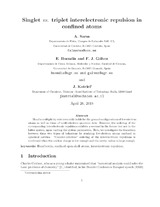Mostrar el registro sencillo del ítem
Singlet vs. triplet interelectronic repulsion in confined atoms
| dc.contributor.author | Sarsa, A. | |
| dc.contributor.author | Buendía, E. | |
| dc.contributor.author | Gálvez, F.J. | |
| dc.contributor.author | Katriel, J. | |
| dc.date.accessioned | 2019-05-24T12:18:35Z | |
| dc.date.available | 2019-05-24T12:18:35Z | |
| dc.date.issued | 2018 | |
| dc.identifier.uri | http://hdl.handle.net/10396/18642 | |
| dc.description.abstract | Hund’s multiplicity rule invariably holds for the ground configurations of few-electron atoms as well as those of multi-electron quantum dots. However, the ordering of the corresponding interelectronic repulsions exhibits a reversal in the former but not in the latter system, upon varying the system parameters. Here, we investigate the transition between these two types of behaviour by studying few-electron atoms confined in spherical cavities. “Counter-intuitive” ordering of the interelectronic repulsions is confirmed when the nuclear charge is low enough and the cavity radius is large enough. | es_ES |
| dc.format.mimetype | application/pdf | es_ES |
| dc.language.iso | eng | es_ES |
| dc.publisher | Elsevier | es_ES |
| dc.rights | https://creativecommons.org/licenses/by-nc-nd/4.0/ | es_ES |
| dc.source | Chemical Physics Letters 702, 106-110 (2018) | es_ES |
| dc.subject | Hund’s rule | es_ES |
| dc.subject | Confined open-shell atoms | es_ES |
| dc.subject | Interelectronic repulsion | es_ES |
| dc.title | Singlet vs. triplet interelectronic repulsion in confined atoms | es_ES |
| dc.type | info:eu-repo/semantics/article | es_ES |
| dc.relation.publisherversion | http://dx.doi.org/10.1016/j.cplett.2018.04.060 | es_ES |
| dc.relation.projectID | Gobierno de España. FIS2015-69941-C2-1-P | es_ES |
| dc.relation.projectID | Gobierno de España. FIS2015-69941-C2-2-P | es_ES |
| dc.relation.projectID | Junta de Andalucía. FQM-220 | es_ES |
| dc.relation.projectID | Junta de Andalucía. FQM-378 | es_ES |
| dc.rights.accessRights | info:eu-repo/semantics/openAccess | es_ES |

